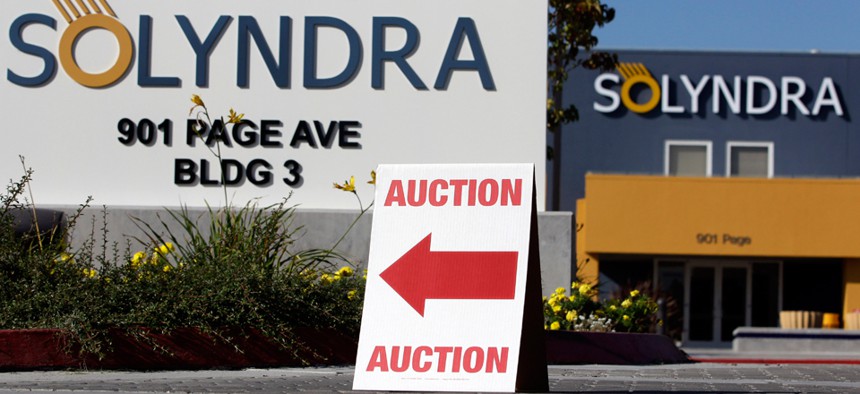
Paul Sakuma/AP file photo
How Washington Bungled the Solyndra Story
The former head of the Energy Department loan program corrects the record.
Most people have heard about the Solyndra program only in the context of scandal. And to hear Republicans yelling about it a few years ago, you'd think the Energy Department's loan guarantee program, which provided financing for Solyndra, was practically synonymous with failure.
And yet no smoking gun or any real evidence of "crony capitalism" ever emerged. Even the claim that the government was picking political losers was wrong in context. Solyndra represented just 1.3 percent of an otherwise strong portfolio, and now that message is coming home to roost. Last week, the department revealed its much-maligned loan program has started turning a profit and is on track to make taxpayers $5 billion or more, according a first-ever estimate of gains.
In an interview with National Journal, Jonathan Silver, who served as head of the clean-energy loan program during Washington's peak Solyndra era, put the numbers in context. "The DOE loan program record is better than virtually every bank and clean-energy investor in that space over the same period," he said. Silver, who stepped down from his position as head of the loan program in 2011, has long argued that the overall loan program was well structured. Now he has the numbers to prove it.
The agency has lent a total of $34.2 billion with the aim of speeding development of clean-energy technology, and companies have defaulted on just $780 million of that so far, a loss rate of roughly 2 percent. In addition, the agency has collected $810 million in interest, putting the program $30 million in the black.
The findings are particularly striking because the program was never expected to make money. When it was created in 2005, Congress predicted there would be losses and set aside $10 billion to cover them. "If we only go after projects we know are going to succeed," Joe Aldy, who worked as a special assistant to the administration for energy in 2009, told Bloomberg Businessweek recently, "all we're doing is subsidizing people for what they'd do anyway."
It also isn't particularly surprising that the department didn't have favorable numbers to tout early on. That the losers lose before the winners win is something of an adage within the investment community, a phenomenon known as the J curve. "You are never going to have an early success in the program because the projects actually have to get built. It takes time," Silver explained. "Project finance professionals and other investment professionals clearly understand this."
Yet Mitt Romney, an unusually financially sophisticated candidate, made the demise of Solyndra a central theme of his presidential campaign in 2012. Visiting the solar manufacturer's shuttered headquarters in California, he attacked the president on jobs, estimating "about half" the businesses the loan guarantee program had invested in had gone under.
The true number of failures at the time was only three out of several dozen—it has since crept up to four. As recently as Tuesday, Rep. Marsha Blackburn, the vice chair of the House Energy Committee's oversight panel, was still declaring "most of these companies are bankrupt and are no longer in existence, and the taxpayer is left holding the bag."
It's the nature of media to point out where government stumbles rather than where it succeeds, but a sampling of headlines from when the story broke in 2011 shows just how little perspective most coverage offered. Republicans made news on the topic regularly with congressional grillings and flashy talking points, and it took a skillful reporter with some editorial freedoms to divine how to intelligently cover or—perhaps more aptly—not cover it.
Silver, for his part, thinks the Solyndra story illustrates a larger problem in media: a proclivity toward quick gets and political theater rather than trying to understand what's happening. "The program is complicated and technically complex," said Silver, now a consultant and senior adviser to clean-energy investors and companies. "It does not lend itself easily to sound bites."
In an interview Friday, Silver walked me through his top media pet peeves. One is reporters suggesting that because Solyndra failed, the larger loan program is a failure, ignoring the rest of the portfolio. Another is reporters saying that the $535 million in loan guarantees allocated to Solyndra were "lost" when it went bankrupt. "It recirculated in the American economy," Silver said. "It may have been suboptimal, but the money's not lost." Meanwhile, success stories, like DOE's early investment in electric-car company Tesla Motors, have largely flown under the radar.
"I think what was so surprising to so many of us was how little context there was around the loans in the portfolio," Silver concluded. "As you can see from these results, the vast majority of the loans have been successful. That's the context."
NEXT STORY: USAJobs Is Getting Another Makeover






